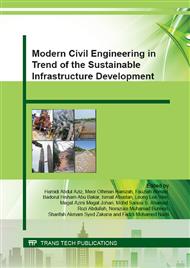p.166
p.172
p.178
p.184
p.190
p.196
p.202
p.208
p.214
Experimental Study on the Effect of Macroroughness on Tsunami Flow and Loading of Building
Abstract:
This study experimentally investigated the effect of nearby buildings, termed macroroughness on the tsunami loading. The hydraulic experiment was conducted in a 1 m x 1 m with 40 m long wave flume at a scale of 1:100. Nominal wave height of 40 mm was simulated in this study. Both the building model and the macroroughness elements consisted of 66 mm high solid blocks. Wave pressures exerted on frontal and back faces of the building model were discussed in detail in this paper. Experimental results showed that the macroroughness elements had a significant impact on tsunami loading in the inundation zone. Sheltering effect was exhibited by the seaward macroroughness elements, showing significant reduction in the front face pressures. With the presence of the landward macroroughness elements, the wave pressures at the back face of the building model increased significantly at the initial impact.
Info:
Periodical:
Pages:
190-195
Citation:
Online since:
October 2015
Authors:
Keywords:
Price:
Сopyright:
© 2015 Trans Tech Publications Ltd. All Rights Reserved
Share:
Citation:


